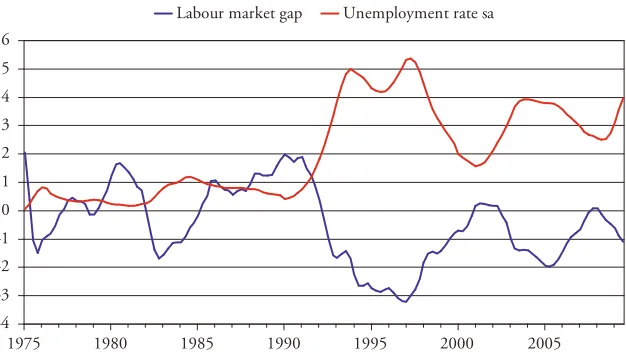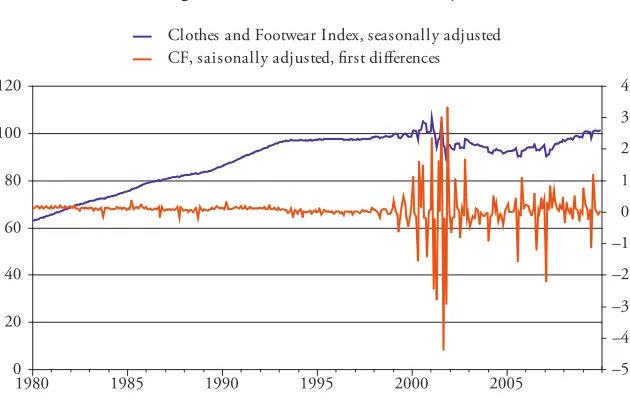© Swiss Society of Economics and Statistics 2010, Vol. 146 (1) 215–220 a Economic Analysis Unit, Swiss National Bank, 8022 Zurich, Switzerland and University of
Basel, Switzerland. E-mail: attilio.zanetti@snb.ch. I wish to thank Nicolas Cuche, Daniel Kaufman, Florence Miguet, Susanne Otto and Michel Peytrignet for helpful discussions. The views expressed in this paper are those of the author and do not necessarily reflect those of his affiliations.
“Unemployment and Monetary Policy in Switzerland” by Peter Kugler and George Sheldon
Attilio Zanettia
In their contribution, Kugler and Sheldon (2010) (henceforth KS) adopt the so-called Battle-of-the-Mark-ups model developed by Layard and his co-authors (1986, 1991) to address a series of issues regarding the link between inflation and the labour market as well as the behaviour of inflation itself (average inflation level, inflation persistency and the role of lagged inflation in shaping expecta-tions). They then bring the model to the data and try to gauge whether the intro-duction of the new monetary policy framework has brought about any signifi-cant changes to these factors.
1. The Approach
The idea of a link between labour market conditions and inflation has been recently resumed by Blanchard and Gali (2008). They construct a New Key-nesian model with labour market frictions, real wage rigidities and staggered price settings and formally derive a relation between inflation and labour market tightness. Tighter labour market conditions increase hiring costs which, in turn, affect the marginal cost and thus inflation. Labour market tightness can be deter-mined by both the level and the change in unemployment, depending on the fundamental features of a given labour market.
The NAIRU was born as an empirical concept. It is however, extremely diffi-cult to obtain reliable and precise estimates of it. This point was made convinc-ingly by Steiger, Stock and Watson, 1996 and 1997. As Chang (1997) points out, this might well be the symptom of the weak theoretical foundation of the concept. In the NAIRU spirit, when unemployment goes too low it will lead via higher wages to higher price inflation. The relation between inflation and unem-ployment, however, appears to be fairly unstable. Unemployment can be either positively or negatively correlated with inflation, depending on the nature of the shocks affecting the economy, including the shocks to inflation expectations. This raises the issues of the correct model specification. The second discussant deals with the question of inflation expectations. Let me thus focus on some other aspects. In KS two variables are meant to capture supply shocks: commodity prices expressed in Swiss francs and a series of dummy variables corresponding to changes in unemployment benefits regulation. A more detailed specification of shocks might be beneficial. First, a broader-defined variable such as the ratio of the imported CPI component over total CPI might be more appropriate to capture the full extent of relative price shocks. Galì and Lopez-Salido (2001), for instance, find evidence that prices of imported intermediate goods matter for both observed and expected inflation. A second important aspect is the role of labour supply shocks. With the implementation of the bilateral agreements with the EU, the Swiss labour market has undergone a major change with this respect (Miguet and Zanetti, 2008). Bentolila, Dolado and Jimeno (2008) find that the immigration boom of the second part of the 1990s has significantly shifted and flattened the Phillips curve in the case of Spain. A third factor that should be explicitly accounted for is productivity. Controlling for VAT effects is also something worth considering.
relevance of wages in the transmission of inflationary pressures. Most of the avail-able research shows little evidence of wages (Granger-) causing price inflation. Mehra (2000) argues that while price inflation helps explain wage growth across various inflation regimes, wage changes help predict price inflation only during period of high and accelerating inflation. Similar results were found for Swit-zerland (Zanetti, 2007): price inflation exerts a systematic impact on nominal wages whereas the explanatory power of wages with respect to price inflation has vanished since the beginning of the 1990s. Other factors, such as relative price shocks, clearly dominate wages in explaining the price inflation pattern.
2. Is Unemployment the Right Variable to Measure Labour Market
Imbalances in Switzerland?
3. Inflation Persistency and the New Monetary Policy Framework
The strongest piece of evidence obtained by KS relates to inflation persistency. The latter appears to have declined after the introduction of the new monetary policy framework, as the sum of the lagged inflation parameters fell from 0.97 to 0.88 across sample periods. Can a robust causality link between the new mon-etary policy framework and this result be established? May 2000 is also the point in time when the Federal Statistical Office modified the way in which prices for clothes and footwear (CF) were measured, by taking sales in more explicit account. As it turned out the beginning of the sale season can vary quite substan-tially from one year to the next. Figure 2 shows how this irregular component has impacted the CF subindex in the CPI (Huwiler and Kaufmann, 2010).
We estimate a simple AR(p) process using the official CPI data. The sum of the (statistically significant) autoregressive parameters is 0.98 for the period 1980–1999 and 0.89 for the period 2000–2009. Hence, the drop in the estimated sum of parameters is of the same order of magnitude as the one found by KS. Next we do the same exercise with the CPI time series excluding the CF com-ponent. The estimated sum of coefficients varies from 0.97 in the first sample period to 0.94 in the second sample period. This seems to suggest that although the drop in inflation persistency is simultaneous to the implementation of the
Figure 1: Unemployment Rate vs. Labour Market Gap, 1975–2009
-4 -3 -2 -1 0 1 2 3 4 5 6
new monetary policy framework it is not necessarily a consequence of it. Elmer and Maag (2009) conduct a detailed analysis of Swiss inflation persistency at the disaggregated level. The come to the conclusion that a significant decline in inflation persistency is indeed observable. The break, however, is located in 1993. No further significant decline is observed in the period after 2000.
4. Conclusion
The issues addressed by the KS paper are crucial from the perspective of the monetary authorities. The authors provide first valuable results that cannot, however, be considered as conclusive evidence. Further investigations – possibly based on an extended data set – are certainly needed for a better understanding of the new monetary policy framework’s impact on actual and expected inflation as well as on the link between various shocks, monetary policy and the labour market outcome.
Figure 2: Sales and Inflation Persistency
0 20 40 60 80 100 120
1980 1985 1990 1995 2000 2005 –5
–4 –3 –2 –1 0 1 2 3 4 Clothes and Footwear Index, seasonally adjusted
References
Bentolila, Samuel, Juan J. Dolado and Juan F. Jimeno (2008), “Does Immi-gration Affect the Phillips Curve? Some Evidence for Spain”, European
Eco-nomic Review, 52, pp. 1398–1423.
Blanchard, Olivier and Jordi Galí (2008), “Labor Markets and Monetary Policy: A New Keynesian Model with Unemployment”, http://papers.ssrn. com/sol3/papers.cfm?abstract_id=920959.
Chang, Roberto (1997), “Is Low Unemployment Inflationary?”, Economic Review, Federal Reserve Bank of Atlanta, First Quarter.
Elmer, Simone and Thomas Maag (2009), “The Persistence of Inflation in Swit-zerland: Evidence from Disaggregated Data”, KOF Working Paper, N. 235. Galí, Jordi and J.D. López-Salido (2001), “A New Phillips Curve for Spain”,
BIS Papers 3: Empirical studies of structural changes and inflation, Bank for International Settlements, Basel.
Huwiler, Marco and Daniel Kaufmann (2010), “Forecasting Short-Term Inflation: The ARIMA Model, in the Swiss National Bank’s Suite of Infla-tion Forecasting Models”, in: M. Peytrignet and M. Savioz, (eds), SNB Eco-nomic Study, No. 7,forthcoming.
Kugler, Peter and George Sheldon (2010), “Unemployment and Monetary Policy in Switzerland”, Swiss Journal of Economics and Statistics, this issue. Layard, Richard, Stephen Nickel and Richard Jackman (1991),
Unem-ployment: Macroeconomic Performance and the Labour Market, Oxford
Uni-versity Press.
Layard, Richard, and Stephen Nickell (1986), “Unemployment in Britain”,
Economica, 53, pp. 121–169.
Mehra, Yash (2000), “Wage-Price Dynamics: Are they Consistent with Cost Push?”, Economic Quarterly, Federal Reserve Bank of Richmond, 86, pp. 27–43. Miguet, Florence, and Attilio Zanetti (2008), Measuring and Projecting
Swiss Potential Labour Supply: The Role of Migration Flows, SNB, mimeo. OECD (1996), Economic Surveys: Switzerland, Paris.
Staiger, Douglas, James H. Stock and Mark W. Watson (1997), “The NAIRU, Unemployment and Monetary Policy”, Journal of Economic Per-spectives, 11, pp. 33–50.
Staiger, Douglas, James H. Stock and Mark W. Watson (1996), “How Pre-cise Are Estimates of the Natural Rate of Unemployment?”, National Bureau of Economic Research, Working Paper 5477.

